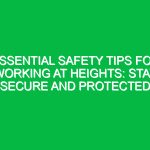Understanding Workplace Assault in the HSE Context
Workplace assault refers to any violent act directed toward a person at work or while on duty. This includes physical attacks, threats, and even psychological abuse. In the Health, Safety, and Environment (HSE) domain, workplace assault poses significant risks not only to individual employees but also to the overall safety culture within organizations. It jeopardizes mental health, affects productivity, and can lead to severe legal and financial repercussions for companies.
In recent years, rising awareness about workplace safety has brought issues like workplace assault to the forefront. The significance of addressing this concern cannot be overstated. As organizations strive to provide safe environments for their employees, understanding the dynamics of workplace assault becomes crucial.
Key Aspects of Workplace Assault
Types of Workplace Assault
Understanding the types of workplace assault is essential for developing effective prevention strategies. They can be categorized as follows:
- Physical Assault: This includes any form of physical violence such as hitting, pushing, or using weapons.
- Verbal Assault: Threatening language, bullying, or harassment falls under this category.
- Psychological Assault: Actions or behaviors that cause emotional distress, including manipulation or intimidation.
Each type has its own implications and requires tailored strategies for prevention and response.
Indicators of Workplace Assault Risk
Recognizing the warning signs of potential workplace assault can help organizations take proactive measures. Some indicators include:
- Increased employee complaints about workplace culture.
- Frequent conflicts between staff members.
- High turnover rates or absenteeism.
- Reports of bullying or harassment.
A culture that promotes open communication can mitigate these risks. Employees should feel empowered to report issues without fear of retribution.
Safety Strategies for Prevention and Response
Establishing a Safety Culture
Creating a safety-conscious culture is paramount in preventing workplace assault. This involves:
- Training and Education: Implement regular training programs that educate employees about recognizing and responding to potential assault situations.
- Clear Policies: Develop and communicate zero-tolerance policies regarding violence and harassment in the workplace.
- Encouraging Reporting: Foster an environment where employees feel comfortable reporting incidents or concerns without fear of negative consequences.
Real-life scenarios illustrate the importance of a safety culture. For instance, a retail store that implemented a training program on recognizing aggressive customer behaviors saw a 40% decrease in reported incidents over one year. Employees felt empowered to de-escalate situations before they escalated into physical confrontations.
Implementing Safety Protocols
Once a safety culture is established, organizations must implement specific protocols to address workplace assault. These protocols should include:
- Emergency Response Plans: Develop clear and accessible plans outlining steps to take during an assault. This should include evacuation routes and emergency contacts.
- Incident Reporting Procedures: Create a standardized process for reporting incidents of workplace assault, ensuring thorough documentation and follow-up.
- Support Services: Provide access to counseling and mental health services for employees affected by workplace assault.
In a manufacturing plant, an incident response plan was put into action after an assault occurred. The company trained employees on emergency procedures and established a communication system that enabled rapid reporting of incidents. This proactive approach led to better management of subsequent events, ensuring the safety and well-being of all employees.
Regular Risk Assessments
Conducting regular risk assessments is vital in identifying potential hazards related to workplace assault. This involves:
- Reviewing incident reports and trends.
- Conducting employee surveys to gauge perceptions of safety.
- Evaluating the effectiveness of current safety measures and making necessary adjustments.
For example, a healthcare facility that regularly assessed its environment discovered that certain areas were prone to higher levels of aggression from patients. By reallocating security resources and adjusting staffing levels, the facility significantly reduced incidents of workplace assault.
Regulations and Standards Governing Workplace Assault
Various regulations and standards govern workplace safety and specifically address workplace assault. Key regulations include:
- Occupational Safety and Health Administration (OSHA): OSHA mandates that employers provide a workplace free from recognized hazards, including violence. Employers are required to develop and implement safety and health programs that address these risks.
- Equal Employment Opportunity Commission (EEOC): This agency enforces laws against workplace harassment, including sexual harassment, which can escalate into assault.
- State Regulations: Many states have their own laws concerning workplace violence, often requiring specific measures to protect employees.
Understanding these regulations is crucial for organizations to ensure compliance and protect their employees. Non-compliance can lead to severe consequences, including fines and legal actions.
Conclusion
Confronting workplace assault is not merely a legal obligation; it is an ethical imperative. A safe work environment fosters employee well-being, enhances productivity, and builds a positive organizational reputation. By establishing a safety culture, implementing robust protocols, and adhering to regulations, companies can significantly reduce the risk of workplace assault.
As we navigate the complexities of modern work environments, it is crucial for all stakeholders—employers, employees, and regulatory bodies—to prioritize safety and well-being. Everyone has a role to play in creating a workplace where every individual feels secure and respected. Continuous education, open communication, and proactive measures can pave the way for a safer future in the workplace. Remember, the best defense against workplace assault is a well-informed and prepared workforce.


